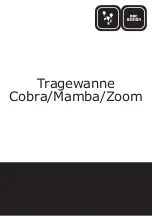
LT8708
25
Rev 0
The I
IN
and I
OUT
currents can be limited and regulated to
independent maximum positive values. When I
IN
causes
IMON_INP to rise near or above 1.209V (typical), EA5
typically causes V
C
to pull down and limit/regulate the
maximum current. Similarly, when I
OUT
causes IMON_OP
to rise near or above 1.209V (typical), EA6 typically causes
V
C
to pull down and limit/regulate the maximum current.
See Table 3 for error amplifier priorities.
The I
IN
and I
OUT
currents can also be limited and regu-
lated to independent maximum negative values. When I
IN
causes IMON_INN to rise near or above 1.21V (typical),
EA1 causes V
C
to pull up and limit the maximum current.
Similarly, when I
OUT
causes IMON_ON to rise near or
above 1.21V (typical), EA2 causes V
C
to pull up and limit
the maximum current.
The I
IN
and I
OUT
current limits can provide many benefits.
They can be used to prevent overloading the input sup-
ply, allow for constant-current battery and supercapacitor
charging and can also serve as short-circuit protection
for constant-voltage regulators. See the Applications In-
formation section for more information about the current
monitors and the current regulation and limiting.
Monitoring: ICP and ICN Pins
ICP and ICN are additional current monitor pins with
output currents typically equal to those of IMON_OP and
IMON_ON, respectively.
In contrast to IMON_OP, ICP is internally pulled to ~0.6V
(typical) when V
C
is at its minimum and the conduction
mode is either RDCM or RHCM. Also, in contrast to
IMON_ON, ICN is internally pulled to ~0.6V (typical) when
V
C
is at its maximum and the conduction mode is FDCM,
FHCM or Burst Mode operation.
Always connect a 17.4k resistor from ICP to ground and
from ICN to ground.
INTV
CC
/EXTV
CC
/GATEV
CC
/LDO33 POWER
Power for the top and bottom MOSFET drivers, the LDO33
pin and most internal circuitry is derived from the INTV
CC
pin. INTV
CC
is regulated to 6.3V (typical) from either the
V
INCHIP
or EXTV
CC
pin. When the EXTV
CC
pin is left open
or tied to a voltage less than 6.2V (typical), an internal low
dropout regulator regulates INTV
CC
from V
INCHIP
. If EXTV
CC
is taken above 6.4V (typical), another low dropout regula-
tor will instead regulate INTV
CC
from EXTV
CC
. Regulating
INTV
CC
from EXTV
CC
allows the power to be derived from
the lowest supply voltage (highest efficiency) such as the
LT8708 switching regulator output (see INTV
CC
Regulators
and EXTV
CC
Connection in the Applications Information
section for more details).
The GATEV
CC
pin directly powers the bottom MOSFET
drivers for switches M2 and M3 (see Figure 3). GATEV
CC
should always be connected to INTV
CC
and should not be
powered or connected to any other source. Undervolt-
age lockouts (UVLOs) monitoring INTV
CC
and GATEV
CC
disable the switching regulator when the pins are below
4.65V (typical).
The LDO33 pin can provide power to external components
such as a microcontroller and/or can provide an accurate
bias voltage. Load current is limited to 17.25mA (typical).
As long as
SHDN
is high, the LDO33 output is linearly
regulated from the INTV
CC
pin and is not affected by the
INTV
CC
or GATEV
CC
UVLOs or the SWEN pin voltage.
LDO33 remains regulated as long as
SHDN
is high and
sufficient voltage is available on INTV
CC
(typically > 4.0V).
An undervoltage lockout monitoring LDO33 will disable the
switching regulator when LDO33 is below 3.04V (typical).
CLKOUT AND TEMPERATURE SENSING
The CLKOUT pin toggles at the LT8708’s internal clock
frequency whether the internal clock is synchronized to an
external source or is free-running based on the external R
T
resistor. The CLKOUT pin can be used to synchronize other
devices to the LT8708’s switching frequency. Also, the duty
cycle of CLKOUT is proportional to the die temperature
and can be used to monitor the die for thermal issues.
OPERATION
















































